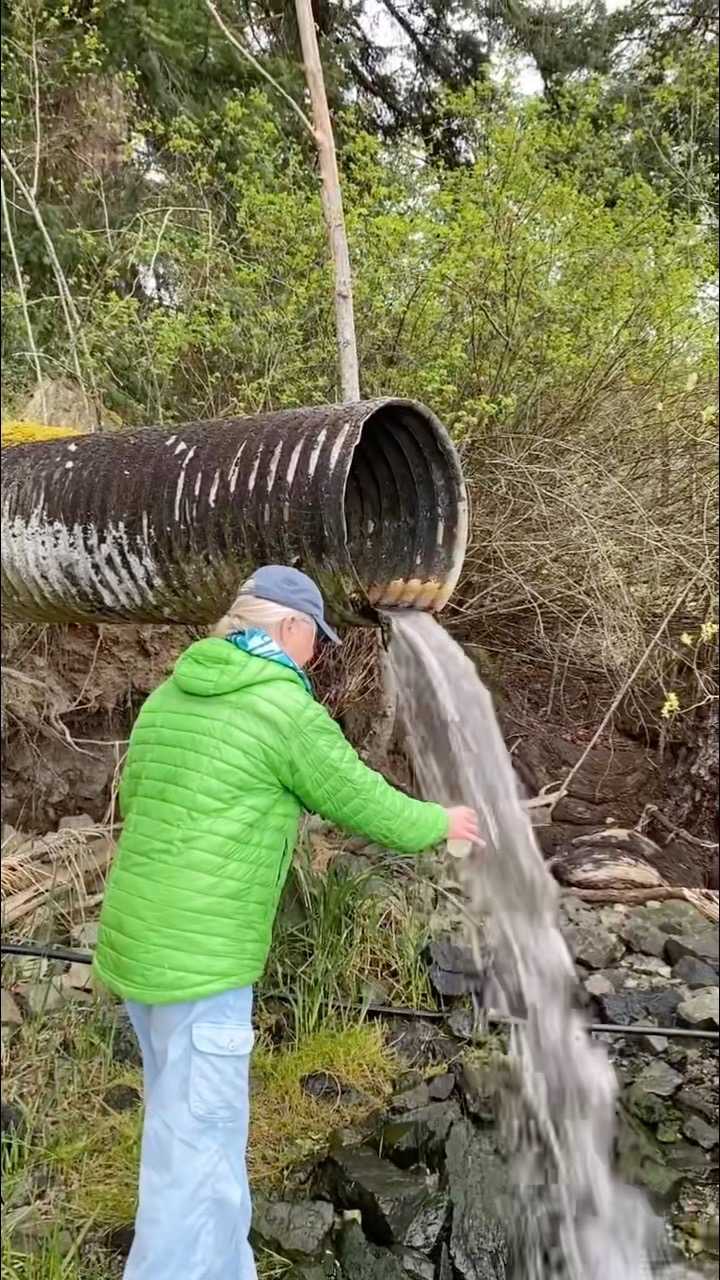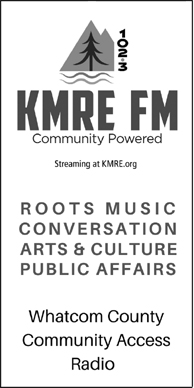by Luisa Loi
Editor’s Note: Whatcom Watch has entered a cooperative agreement with Salish Current. When possible, we will share each other’s content. Salish Current, an online-only news organization, covers the North Sound area and Whatcom Watch mainly covers Whatcom County issues. Visit https://salish-current.org.
Part I
High bacteria counts in stormwater are prompting concerns, as volunteer citizen scientists walk Anacortes and Bellingham shores to help track outfall water quality.
During a routine sampling session in Bellingham Bay last month, a team of citizen scientists came across a stream of brown, frothy and poop-smelling water flowing from the Olive Street stormwater outfall, located just north of Boulevard Park.
Upon analyzing the sample, researchers found E. coli bacteria levels so high that they exceeded the safety threshold by over 50 times, RE Sources shared in an Instagram post.
Kirsten McDade, a pollution expert who leads four stormwater teams for the nonprofit, said the city is currently conducting a DNA test to identify the source.
Every month, groups of volunteer citizen scientists walk the shores of Bellingham and Anacortes to collect samples of untreated water from outfalls and creek mouths with the goal of keeping track of any changes in water quality.

courtesy photo: Shanti Nelson
A volunteer collects a sample from the Fidalgo Bay Road stormwater outflow near Anacortes.
Stormwater Monitoring Program
This work is part of a growing effort known as the Stormwater Monitoring Program, an initiative of Friends of the Salish Sea. The environmental nonprofit, based in Anacortes, has been taking samples from eight cities in the region that are covered by a Phase II Municipal Stormwater Permit, which regulates the discharge of stormwater from moderately sized cities.
The findings are then shared with the cities, which will work to investigate and mitigate the contamination, though contaminated stormwater is one of the most difficult forms of pollution to prevent.
“We’re trying to be the first boots on the ground,” Shannon Valderas, the Stormwater Monitoring Program’s project coordinator, said about the nonprofits.
As stated in RE Sources’ report, stormwater also represents the greatest source of pollution in the sea, where it introduces bacteria, chemicals and sediment.
These contaminants — which can come from unscooped pet poop, leaked motor oil, fertilizer and other substances — get swept by the rains and fast-tracked from hard surfaces like streets, roofs and even lawns, where soil and plants can’t act as natural filters; they are then flushed through storm drains, pipes and the outfalls, finally reaching natural bodies of water.
While experts agree that there is no reason to panic or avoid going to the beach completely, they acknowledge that swimming in urban waters without taking the right precautions can come with risks, though evidence of locals getting sick from water exposure has been anecdotal rather than reported to health authorities.
“I think people need to just understand the risks and make those decisions themselves based on their comfort level and also health status,” McDade said.
As scientists further dive in to find more answers, awareness and small changes in daily habits can help beachgoers stay safe and protect their aquatic neighbors.
Monitoring in Bellingham
RE Sources joined forces with Friends of the Salish Sea in 2020 and has since been releasing a yearly stormwater report detailing the contamination affecting four creeks and six outfalls.
The latest report, released this spring, shows that the contamination levels for water discharged into Bellingham Bay consistently exceed quality standards set by the state.
While 2024 saw 294 exceedances to 2023’s 167, RE Sources believes this increase might be because volunteers were given clearer directions on how to assess water quality, and they collected more data.
McDade said that while the contamination doesn’t seem to be getting worse, the lack of improvement still represents a decline.
The sites can receive one of three ratings: “good,” “watch” or “threat.” In 2024, all six of the outfalls and three out of four creeks were rated as “threat” as they frequently violated quality standards or had a high likelihood of human exposure, according to the report. Just as in the previous year, none of the creeks or outfalls were “good,” RE Sources found.
Some of the sites, like the Broadway outfall and the C Street outfall, show obvious signs of pollution, such as a yellowish color, a sulfur smell and a white mat of microbes on the surface, as detailed in the report. Other signs volunteers and scientists look for include algae, warm water temperatures, turbidity, the smell of fossil fuels, dissolved oxygen, conductivity, E. coli bacteria and other pathogens.
Yet ironically, one of the spots with the worst bacteria counts happens to be rather inconspicuous — and somewhat visually charming. Despite looking like a “pizza oven” with a clean-looking, rarely smelling rivulet of water coming out of it, as McDade said, the Bennett Street outfall has frequently shown “very high” bacteria exceedances, the report shows.
The outfall drains the hillside south of Boulevard Park and can be seen from Taylor Dock, discharging in front of the Chrysalis hotel.
Three quarters of the samples collected from this location in 2024 presented high bacteria counts, often exceeding limits by three to 15 times and showing similar levels to those detected in 2021 and 2022, the report states.
Last month, samples showed more than 3,000 CFU – or “colony-forming unit” used to estimate the number of viable bacteria cells in a sample – equaling 10 times the bacteria safety threshold, according to the Instagram post.
The Bennett outfall is near the Taylor floating dock, a popular spot for swimmers.
Risk of Human Exposure
Because of the risk of human exposure, the state Department of Ecology sampled the water in front of the outfall 10 times between May and August of last year as part of the Beach Environmental Assessment, Communication and Health Program — which monitors the quality of marine water to ensure it’s safe for recreation.
The water directly in front of the outfall exceeded safety limits for bacteria three out of 10 times, enough to prompt the two state agencies to install a sign warning beach-goers that contact with the water “may cause illness” and to “swim at (their) own risk.”
Swimming directly in front of the outfall is not recommended, but samples collected from surrounding waters suggest they are generally safe. Test results from Taylor dock in fact have not shown any exceedances — instead, they were lower than the safety threshold, McDade said.
When asked what distance swimmers should keep from a contaminated outfall in order to be safe, she did not have an answer. All that is known so far is that, somewhere between the dock and the outlet, the water becomes safe, and that the safety line’s location might depend on factors such as water temperature, tides, currents and the amount of bacteria flushed, she said.
Bryan Rust, executive director of the Community Boating Center, concurs that contaminants seem to dilute once they enter the water.
“The conditions near our facilities remain perfectly safe for recreation, certainly thanks in part to tidal flushing and open water circulation,” he said.
The boating center, which is located about 400 yards away from the Bennett outfall, has been supporting RE Sources’ monitoring efforts and testing the water at the Fairhaven boat launch and other nearby sites that were found to be safe. This summer, the boating center will recruit an intern to take samples on a weekly basis.
While its recreational programs have been unaffected, Rust said the center will have a plan in place in the scenario that bacteria levels high enough to put people’s health at risk are found near its facilities, modifying programs rather than cancelling them altogether.
See the original article here: https://salish-current.org/2025/06/18/troubledwaters-stormwater-bacteriacounts-stir-up-concerns/
Next Month Part II: Forever Chemicals
_______________________________________
Luisa Loi is a freelance reporter for Salish Current. After graduating from Western Washington University in 2022, she wrote for the Whidbey News-Times and Whatcom Watch. She mostly enjoys writing about the environment, social issues and people with unique stories, crafting, exploring the Pacific Northwest and finding her next binge-able TV show.





























